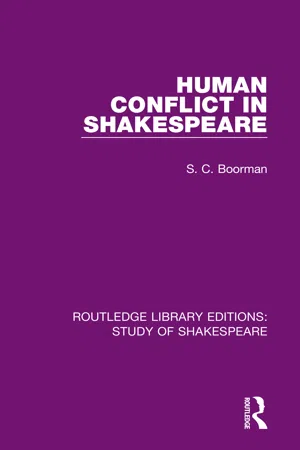
- 336 pages
- English
- ePUB (mobile friendly)
- Available on iOS & Android
Human Conflict in Shakespeare
About This Book
Conflict is at the heart of much of Shakespeare's drama. Frequently there is an overt setting of violence, as in Macbeth, but, more significantly there is often 'interior' conflict. Many of Shakespeare's most striking and important characters – Hamlet and Othello are good examples – are at war with themselves.
Originally published in 1987, S. C. Boorman makes this 'warfare of our nature' the central theme of his stimulating approach to Shakespeare. He points to the moral context within which Shakespeare wrote, in part comprising earlier notions of human nature, in part the new tentative perceptions of his own age. Boorman shows Shakespeare's great skill in developing the traditional ideas of proper conduct to show the tensions these ideas produce in real life. In consequence, Shakespeare's characters are not the clear-cut figures of earlier drama, rehearsing the set speeches of their moral types – they are so often complex and doubting, deeply disturbed by their discordant natures. The great merit of this fine book is that it displays the ways in which Shakespeare conjured up living beings of flesh and blood, making his plays as full of dramatic power and appeal for modern audiences as for those of his own day. In short, this book presents a human approach to Shakespeare, one which stresses that truth of mankind's inner conflict which links virtually all his plays.
Frequently asked questions
Information
PART ONE
Forms of human conflict
(a) Soul-body
A Man is than[then] a certayn monstrousbeest compact togyder of partes, two or threof great dyuersite. Of a soule, as of a certeynegoodly thynge: and of a body, as it were a bruteor dombe beest. For certeynly, we so greatlyexcell not al other kyndes of brute beestesin perfytnes of body but that we in al hisnatural gyftes, are founde to them inferyours:as concernyng ye soule veryly, we be soreceyuable of ye diuyne nature: that we maysurmount aboue the nature of angels and bevnyt[united], knyt, and made one with god. Yfthy body had not ben added to the[thee] thouhaddest ben a celestial or godly thyng. Yf thismynde had not ben graffed in the[thee] playnlythou haddest ben a brute beest. These two naturesbytwene them self so diuerse: that excellentwerkman had coupled togyder with blessedconcorde. But the serpent the enemy of peace,put them asonder agayn with vnhappy discorde:so yt now they neyther can be seperate, withoutvery great turment and payn neyther lyue ioynedtogyder, without continual warre.2
So man is created by God, tanquam mediusinter angelum & brutu, a middling betweene anAngell, and a brute; being a good deale betterthen a beast, and a littleq lower then an Angell.Hauing in respect of his body, something of abruit, being sensuall and mortall; and in respectof his soule, something of an Angell, as beingintellectuall and immortall3
(b) Immortal-mortal
We see great men dye, strong men dye,wittie[clever] men dye, fooles dye, richMerchants, poor Artificers, Plowmen,Gentlemen, high men, low men, wearish [sickly] men,grosse men, and the fairest complexioned[most healthy] men die, yet we perswadeour selues wee shall neuer dye. Or if wedo not so perswade our selues, why preparewee not to dye? Why doe wee raigne as Godson the earth, that are to bee eaten withwormes?4
(c) Greatness-littleness
Who can sufficiently expresse or wonderenough at the excellencie of man, so little acreature made but of the dust? That heby contemplation should soare vp to theskies, and be able to discourse of themotions, aspects, and effects of thecelestiall orbe; that he should ride vpon theSeas, and search, and passe ouer the liquidfloods; that he should vendicate[claim] bothearth and sea vnto his profit, and domineereouer the beasts, and know the nature of all thecreatures; that he should contriue the Artsand Sciences to a methode, and being absentto speak to men farre distant by letterswritten, that he should in this mortalitieseeke after immortalitie, and haue a seateprepared for him in heauen, after life endedhere on earth ... No tongue is able to express5
double is the nature of man, and a perfectman is a double man in him selfe, one without,and another within: without [outside] his bodyis man, and within his minde, so as there isboth an outward, and an inward man, and bothin one, if that one have the perfection of aman.... (Man) being considered in his beginning,and after his ende truly as he is, by an auntientFather, is sayed to be, Semen immundum, cibusvermium, post hominem vermis, post vermen faetor et horror.Vncleane seed, wormes meate, after a man a worme,(after a worme) an ill sauor and a horror. Whichtwo natures in man, as they were found to differ,so were they by name distinguished even at thefirst; the first earthly man being of theHebrewes called Adam, as homo tanquam ex humo(man inasmuch as from earth), and the otherheauenly of the Chaldeans Enoch, which signifiethtrue man6 Ambros de Isa et anima.
I know my bodie’s of so frail a kind,As force without, feavers within can kill;I know the heavenly nature of my minde,But ‘tis corrupted both in wit and will:I know my Soule hath power to know all things,Yet she is blind and ignorant in all;I know I am one of Nature’s little kings,Yet to the least and vilest things am thrall.I know my life’s a pain and but a span,I know my Sense is mockt with every thing:And to conclude, I know my selfe a MAN,Which is a proud, and yet a wretched thing.7
(d) Freedom-fate
Table of contents
- Cover
- Half Title
- Title Page
- Copyright Page
- Original Title Page
- Original Copyright Page
- Table of Contents
- Introduction
- Part 1 Forms of human conflict
- Part 2
- Part 3 Human conf lia in Shakespeare
- Appendix 1 Marlow’s Doctor Faustus
- Appendix 2 Comedy and tragedy in drama
- Notes
- Indexes
- 2 Shakespeare’s plays: (a) titles (b) characters
- 3 Non-Shakespearean plays: titles
- 4 General